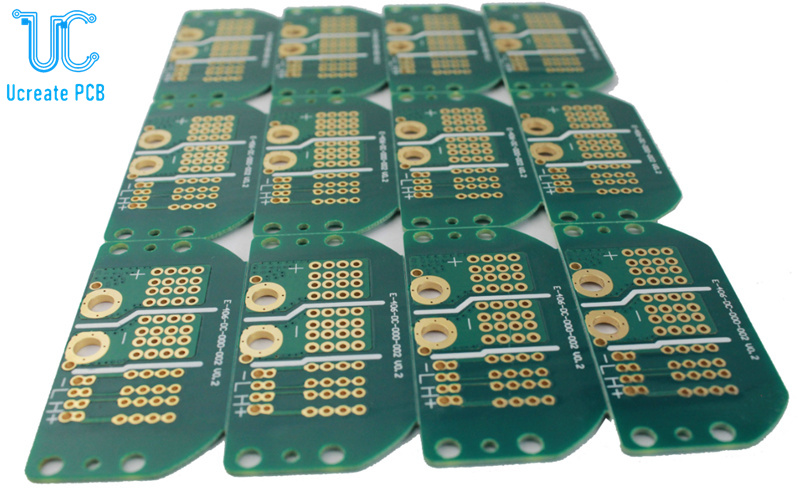Categories
What is a thick copper circuit board? Thick copper circuit boards are bonded with a layer of copper foil on the outer layer of FR4. When the finished copper thickness is ≥ 2oz, it is defined as a thick copper circuit board. PCB thick copper plate is resistant to high temperature and corrosion. It is mainly used in products with power storage, especially electronic products that need to run higher voltage and current. PCB thick copper plate is required. The thicker the hole copper of the PCB, the better. All the data need to be made according to the customer's requirements. PCB thick copper plate has very good elongation performance and is not limited by processing temperature. When the melting point is high, oxygen blowing can be used, and it will not be brittle at low temperature. It is also fireproof and is a non-combustible material. Thick copper PCB has different thicknesses., the specific applicable occasions are also quite different.

PCB thick copper boards are different due to the use and the current size and thickness of the signal. The circuit board with a finished copper thickness greater than or equal to 2OZ is called a thick copper board. With a finished copper thickness of 2OZ, manual silk screen printing is not enough to fill the gap between the lines. Print the solder mask twice. When encountering 2Oz and thicker PCBs during PCB production, PCB thick copper plates will be noted during solder masking, and secondary silk screen printing is required. In order to achieve the effect that the line does not glow red and the thickness of the solder mask on the line surface is greater than 10um. Copper plating generally has primary copper and secondary copper. The main purpose of primary copper is to provide sufficient copper thickness for secondary copper etching to ensure that the copper thickness after secondary copper etching can meet the customer's copper thickness standard requirements.
Historical Background:
The evolution of Thick Copper PCBs can be traced back to the late 20th century when electronic devices started demanding higher power and increased functionality. The need for better heat dissipation and enhanced electrical performance led to the development of Thick Copper PCBs. Initially, these boards were primarily used in military and aerospace applications. However, with advancements in manufacturing processes and the emergence of new technologies, Thick Copper PCBs found their way into various industries, including power electronics, automotive, industrial equipment, and renewable energy.

The role of PCB thick copper ?
With the continuous development of science and technology, people need electronic products with high performance, small size and multiple functions. In order to carry large current, reduce thermal strain, and good heat dissipation, there are more and more electronic products. Industries that benefit from thick copper PCBs are power supply, automotive, solar panel and soldering equipment manufacturers. Copper-plated vias on thick copper PCBs are best for transferring heat to an external heat sink. PCB thick copper boards are made using electroplating and etching techniques to increase the copper thickness on the sidewalls of through holes and plated holes.
Applications of Thick Copper PCBs:
Thick Copper PCBs find extensive applications in industries where high power and thermal management are crucial. Some notable applications include:
a) Power Electronics: Thick Copper PCBs are widely used in power supplies, inverters, motor controllers, and battery management systems, where they enhance efficiency and reduce power losses.
b) Automotive: Thick Copper PCBs enable the development of advanced automotive electronics, such as electric vehicle charging systems, powertrain control modules, and hybrid vehicle applications, ensuring optimal performance under challenging conditions.
c) Industrial Equipment: Thick Copper PCBs are utilized in heavy machinery, robotics, and automation systems that require high power transmission and reliability.
d) Renewable Energy: Thick Copper PCBs play a vital role in solar inverters, wind turbines, and energy storage systems, ensuring efficient power conversion and reliability in renewable energy applications.
Development Prospects:
The demand for Thick Copper PCBs is growing rapidly due to the increasing demand for high-power electronics and the need for reliable and efficient operation. The market for Thick Copper PCBs is expected to grow at a CAGR of 10.5% during the forecast period of 2021-2026, driven by the growth in the automotive, renewable energy, and industrial sectors. The increasing adoption of electric vehicles, the growth of the solar power industry, and the rise in industrial automation are some of the key drivers of the Thick Copper PCB market.
Thick Copper PCB technology is a crucial development in the electronics industry that has opened up new opportunities for high-power applications. Its advantages in terms of current carrying capacity, thermal conductivity, and mechanical strength make it ideal for applications in power electronics, automotive electronics, industrial control systems, and renewable energy systems. With the growing demand for high-power electronics and the increasing need for reliable and efficient operation, the Thick Copper PCB market is expected to grow significantly in the coming years.
Send PCB Files to Sales@ucreatepcb.com, We Will Quote You Very Soon!